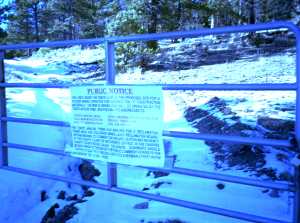Review by Ed Quillen
Local Lore – May 2002 – Colorado Central Magazine
The Ballad of Baby Doe
by Duane A. Smith with John Moriarty
Published in 2002 by University Press of Colorado
ISBN 0-87081-659-4
SEPARATING HISTORY FROM LEGEND can be a tough job, and it may be even harder to discover the history of the legend. Fortunately, Duane Smith and John Moriarty were up to the challenge in That Ballad of Baby Doe.
In general, it’s a history of the opera that was first staged in Central City in 1956. And telling that story also means telling the story of that charming old opera house and its resurrection during the Great Depression.
The book also explores the historical basis of the story in the opera — how Leadville silver baron Horace Tabor left his faithful wife Augusta for a trophy bride named Baby Doe, who stuck with him even after his fortune vanished.
Plus there’s the legend that gets entwined with the history. We all know the scene that never happened. Tabor is on his deathbed, with Baby Doe holding his hand when his last words come: “Hold on to the Matchless. It will make you rich again.”
Just about every aspect of that story is false, and Smith does an excellent job of tracking down the origin of the tale — it was one of Denver writer Caroline Bancroft’s many moments of creative fancy when she was concocting “historical” pamphlets 50 or 60 years ago.
Bancroft considered herself the owner of the Tabor saga, and managed to interject herself into the process as a “historical consultant” in 1954 when the Central City Opera Association decided to commission an original American opera. The Tabor story was a natural. During an earlier marriage, Baby Doe had lived in Central City, and Horace spread his Leadville silver wealth throughout Colorado.
The Ballad of Baby Doe tells the story of how the opera was developed, revised, and staged through the years in both Colorado and New York, and offers interviews with some of the talent, most notably Beverly Sills. And there’s also a brief but thorough biography of Augusta and Horace Tabor, one that demolishes another part of the Tabor myth, which has it that Horace was some sort of semi-literate drunk when he grubstaked a couple of prospectors who struck it rich on Fryer Hill.
In truth, Tabor had served in the Kansas Territorial Legislature before coming to Colorado, and held several public offices here before the big money began rolling in. He and Augusta were fairly prosperous long before the silver boom. His faults were many, but he wasn’t the buffoon that he is often portrayed as.
The authors compare the opera to its historical basis, and find it surprisingly faithful — something of a surprise, given the dramatic compression that must take place to put 20 years of three lives into a two-hour performance.
I’m not an opera-goer, so I can’t really comment knowledgeably on that aspect of this book. But as a history buff, I found it engaging and interesting, and if you’ve got any interest in the Tabor saga or the boom days of 19th-century Colorado, you will too.
–Ed Quillen

